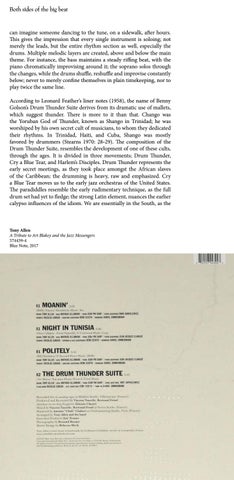Both sides of the big beat
can imagine someone dancing to the tune, on a sidewalk, after hours. This gives the impression that every single instrument is soloing; not merely the leads, but the entire rhythm section as well, especially the drums. Multiple melodic layers are created, above and below the main theme. For instance, the bass maintains a steady riffing beat, with the piano chromatically improvising around it; the soprano solos through the changes, while the drums shuffle, reshuffle and improvise constantly below; never to merely confine themselves in plain timekeeping, nor to play twice the same line. According to Leonard Feather’s liner notes (1958), the name of Benny Golson’s Drum Thunder Suite derives from its dramatic use of mallets, which suggest thunder. There is more to it than that. Chango was the Yoruban God of Thunder, known as Shango in Trinidad; he was worshiped by his own secret cult of musicians, to whom they dedicated their rhythms. In Trinidad, Haiti, and Cuba, Shango was mostly favored by drummers (Stearns 1970: 28-29). The composition of the Drum Thunder Suite, resembles the development of one of these cults, through the ages. It is divided in three movements; Drum Thunder, Cry a Blue Tear, and Harlem’s Disciples. Drum Thunder represents the early secret meetings, as they took place amongst the African slaves of the Caribbean; the drumming is heavy, raw and emphasized. Cry a Blue Tear moves us to the early jazz orchestras of the United States. The paradiddles resemble the early rudimentary technique, as the full drum set had yet to fledge; the strong Latin element, nuances the earlier calypso influences of the idiom. We are essentially in the South, as the
Tony Allen A Tribute to Art Blakey and the Jazz Messengers 574439-4 Blue Note, 2017
42
